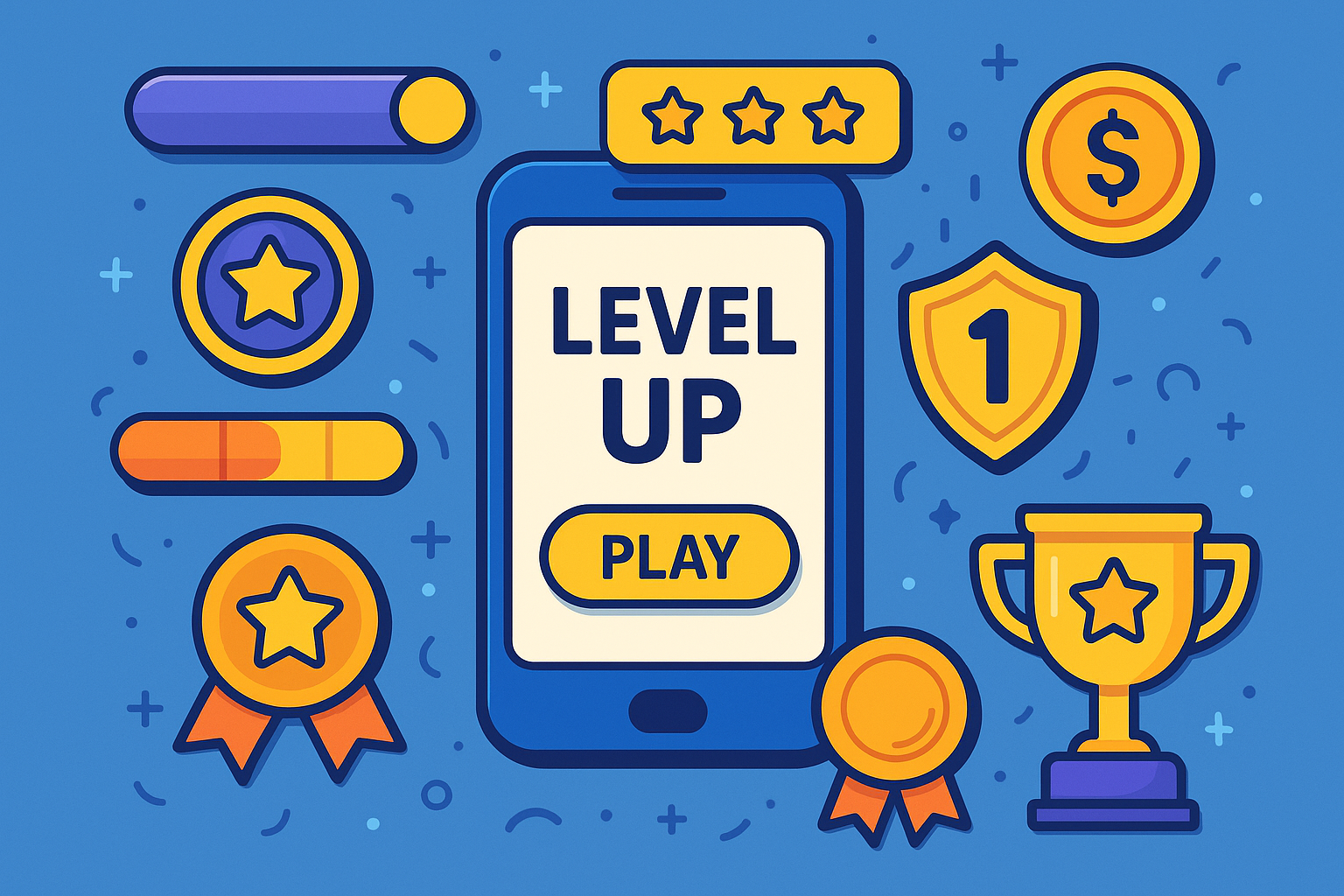In a world where the average person encounters between 6,000 to 10,000 advertisements daily, standing out from the crowd has never been more challenging. Traditional advertising methods are losing their effectiveness as consumers develop “banner blindness” and increasingly skip or block ads. Enter gamification ads—a revolutionary approach that transforms passive viewers into active participants, turning advertising from an interruption into an experience people actually enjoy.
Gamification in advertising isn’t just a trendy buzzword; it’s a proven strategy that’s reshaping how brands connect with consumers. By incorporating game mechanics like points, challenges, rewards, and leaderboards into marketing campaigns, companies are seeing engagement rates soar, brand loyalty deepen, and conversion rates multiply. But what makes gamification ads so effective, and why should your business care?
Understanding Gamification Ads
Gamification ads integrate game-like elements into advertising campaigns to make them more interactive, engaging, and memorable. Rather than simply presenting information about a product or service, these ads invite users to participate in challenges, compete for rewards, or progress through levels—all while subtly promoting a brand message.
The psychology behind gamification is straightforward yet powerful: humans are naturally drawn to play, competition, achievement, and rewards. When these elements are woven into advertising, they tap into fundamental motivations that drive human behavior, creating emotional connections that transcend traditional brand-consumer relationships.
Gamification marketing transforms passive consumers into active participants through mechanics such as points systems, badges and achievements, progress bars and levels, leaderboards and rankings, challenges and quests, instant win games, and reward redemption. These elements work together to create experiences that users actively seek out rather than avoid.
The Market Reality: Gamification Is Booming
The numbers tell a compelling story about the rise of gamification in advertising. The global gamification market, valued at approximately $12 billion in 2024, is projected to reach between $35 billion and $190 billion by 2033, depending on various market analyses. This explosive growth reflects increasing recognition of gamification’s power to drive engagement and business results.
North America currently dominates the gamification landscape, accounting for 41% of global market revenue, with the region’s market valued at $5.22 billion in 2024 and expected to grow at a compound annual growth rate of nearly 27%. The United States and Canada lead this charge, driven by high smartphone penetration and digital-first consumer behavior.
But perhaps the most telling statistic is this: over 80% of businesses that implement gamification report improved engagement metrics, with gamified campaigns increasing customer engagement by nearly 48% compared to traditional advertising methods. Companies using gamified strategies have seen a 22% increase in customer retention and engagement boosts exceeding 100% in some cases.
Why Gamification Ads Work: The Psychology of Play
The effectiveness of gamification ads stems from their ability to tap into deep psychological drivers that motivate human behavior. Understanding these mechanisms helps explain why gamification consistently outperforms traditional advertising.
The Dopamine Effect
When users complete challenges, earn points, or unlock achievements, their brains release dopamine—the neurotransmitter associated with pleasure and reward. This creates positive associations with the brand and motivates users to continue engaging. Each small win in a gamified experience provides a micro-dose of satisfaction that keeps users coming back for more.
Loss Aversion and Streak Maintenance
Gamification leverages loss aversion, the psychological principle that people are more motivated to avoid losing something than to gain something equivalent. Apps like Duolingo exemplify this brilliantly through streak counters—users who have maintained a 100-day learning streak are highly motivated to log in daily simply to avoid losing their progress. This fear of loss can be as powerful, if not more so, than the desire for rewards.
The Endowed Progress Effect
Research shows that people are more likely to complete a task if they believe they’ve already made progress toward it. Gamification ads using progress bars, partially completed challenges, or “starter bonuses” capitalize on this effect, making users feel invested in completing the journey.
Social Proof and Competition
Leaderboards and social sharing features tap into our competitive nature and desire for social recognition. When users see others participating in gamified campaigns, they’re more likely to join in. The competitive element drives sustained engagement as users strive to improve their rankings or outperform friends.
The Zeigarnik Effect
This psychological phenomenon describes our tendency to remember incomplete tasks better than completed ones. Gamification ads that create ongoing challenges or multi-part experiences keep brands top-of-mind as users mentally return to their unfinished “quests.”
The Business Benefits: Why Gamification Ads Matter
Beyond engagement metrics, gamification ads deliver tangible business outcomes that justify investment and strategic priority.
Breakthrough Engagement Rates
In an era where traditional advertising struggles to capture attention, gamification achieves remarkable engagement. Studies show that interactive content, including gamified experiences, receives 52.6% more engagement than static content. Users spend significantly more time interacting with gamified ads compared to traditional formats, creating extended brand exposure and deeper message retention.
According to AI-powered personalization studies, 80% of marketers deploying these strategies in gamified experiences reported a 20% increase in engagement metrics. The interactive nature of gamification cuts through digital clutter and captures attention in ways that banner ads and video spots simply cannot.
Superior Conversion Rates
Engagement is valuable, but conversion is essential. Gamification excels here too. Customer acquisition can increase by up to 700% through gamified systems, while conversion rates for gamified campaigns can reach 9.38%—substantially higher than industry averages for traditional digital advertising.
One case study demonstrated this dramatically: Lawley Insurance closed more sales through a two-week gamified contest than they had in the previous seven months combined. The competitive element and reward structure motivated prospects to take action rather than procrastinating on purchase decisions.
Enhanced Data Collection
Traditional advertising provides limited data about audience behavior and preferences. Gamification ads, however, create rich datasets through user interactions. Every click, choice, completion, and abandonment provides insights into customer preferences, pain points, and motivations.
Importantly, users willingly provide this data because they’re focused on the game experience rather than perceiving it as invasive tracking. Each gamified interaction becomes a feedback mechanism that marketers can use to personalize future campaigns and uncover new engagement opportunities.
Improved Brand Recall and Loyalty
Experiences create memories far more effectively than passive viewing. When customers actively participate in a gamified ad experience, they form stronger neural connections to the brand. The emotional investment created through gameplay translates into better brand recall and increased loyalty.
Starbucks Rewards demonstrates this principle beautifully. By gamifying purchases through a point-based system with tiered levels, Starbucks has created one of the most successful loyalty programs in retail history. Members don’t just remember Starbucks; they actively choose it over competitors to maintain their progress and unlock rewards.
Non-Intrusive Marketing
Perhaps most importantly, gamification transforms advertising from interruption to invitation. Rather than forcing messages onto reluctant audiences, gamified ads create experiences users voluntarily seek out and share with others. Nike Run Club exemplifies this shift—users engage with Nike’s ecosystem not because they’re compelled to, but because they genuinely want to track their progress and compete with friends.
Successful Gamification Ads: Real-World Examples
Understanding theory is important, but seeing gamification in action demonstrates its real-world impact. Here are standout examples across different industries and approaches.
McDonald’s Monopoly: The Classic Case Study
McDonald’s annual Monopoly campaign remains one of the most recognized gamification marketing examples worldwide. By attaching game pieces to food items, McDonald’s transforms ordinary purchases into opportunities to win prizes ranging from free food to million-dollar jackpots.
The genius lies in the psychology: customers must make purchases to collect game pieces, driving repeat visits. The excitement of potentially winning big prizes creates emotional engagement that transcends typical fast-food transactions. In 2017 alone, a $65 million prize pool generated massive media coverage and customer participation.
Starbucks Rewards: Gamifying Loyalty
Starbucks Rewards turns every coffee purchase into progress toward rewards through a star-based point system. Customers advance through Green and Gold tiers, with each level offering increasingly valuable benefits. Limited-time challenges—like earning bonus stars for morning purchases or trying new menu items—keep the experience fresh and encourage specific behaviors.
The mobile app integration makes tracking progress seamless and visible, while push notifications about progress and available rewards keep users engaged between visits. This gamified approach has made Starbucks Rewards one of the most successful loyalty programs across all industries.
Duolingo: Making Learning Addictive
Duolingo revolutionized language learning by incorporating comprehensive gamification. Users earn experience points (XP) for completing lessons, maintain streak counters that track consecutive days of practice, compete on leaderboards within learning leagues, unlock achievements for milestones, and complete daily quests for bonus rewards.
The app’s effectiveness stems from creating small, achievable goals that keep users returning daily. The combination of progress tracking, social competition, and loss aversion (maintaining streaks) has made Duolingo one of the most downloaded education apps globally, with users spending far more time learning than they would with traditional methods.
Nike Run Club: Fitness as Competition
Nike transformed running from a solitary activity into a social, competitive experience through the Nike Run Club app. Users track their runs, compete in challenges, earn trophies and badges, share achievements with friends, and join global community events.
The gamification doesn’t feel forced because it aligns perfectly with Nike’s brand identity and runners’ natural desires to improve performance and share accomplishments. Rather than directly selling shoes, Nike creates ongoing engagement that builds brand affinity and keeps the company top-of-mind when purchasing decisions arise.
Samsung’s Black Friday Interactive Experience
Samsung created a gamified Black Friday campaign where users navigated interactive challenges to unlock deals and discounts. The campaign engaged over 300,000 users and acquired approximately 200,000 new customers—a remarkable conversion rate for a digital advertising campaign.
The key was making the shopping experience itself entertaining rather than simply offering discounts. Users felt they “earned” their deals through participation, creating psychological ownership and satisfaction that straight discount codes couldn’t match.
M&M’s Eye-Spy Pretzel Game
When launching pretzel-flavored M&M’s, the brand created a simple yet viral gamified campaign: find the pretzel hidden among thousands of M&M candies in an image posted online. The challenge spread rapidly across social media as users shared the image and competed to find the pretzel first.
This campaign demonstrates that effective gamification doesn’t require complex technology or massive budgets. A well-designed challenge that taps into human psychology can achieve viral reach and significant brand exposure through user sharing and participation.
Co-op’s Halloween Hit-a-Monster Campaign
UK grocery retailer Co-op launched a Halloween-themed game offering customers guaranteed prizes for their next shopping trip. Running for 10 days before Halloween, the game gave members a fun way to earn discounts while creating holiday excitement.
The campaign successfully boosted both engagement and sales by combining seasonal theming, guaranteed rewards (removing the disappointment of “not winning”), and seamless integration with the shopping experience. Over 50% of participants were new customers, demonstrating gamification’s power for customer acquisition.
Types of Gamification Ads and Mechanics
Gamification encompasses various formats and mechanics, each suited to different objectives and audiences.
Spin-to-Win Wheels
These interactive wheels offer instant gratification and clear visual appeal. Fashion retailer Fashion Nova implemented spin-to-win games on their website, presenting users with a high-contrast wheel offering discounts between 5% and 30%.
The effectiveness increases when combined with exit-intent technology, which detects when users are about to leave the website and presents the wheel as a final engagement opportunity. This approach reduces abandonment by giving visitors a reason to stay and complete a purchase.
Progress-Based Challenges
These campaigns require users to complete multiple steps or tasks over time, building sustained engagement. Each completed step provides satisfaction while creating anticipation for the next milestone.
Instant Win Games
Immediate gratification drives participation in instant win formats. Users know immediately whether they’ve won prizes, eliminating the delayed gratification problem that can reduce participation in other contest formats.
Branded Mini-Games
Custom-built games featuring brand elements and messaging create immersive experiences. KFC Japan partnered with gamification specialists to create a mobile game where users swatted falling shrimp (similar to Fruit Ninja) to promote their new shrimp menu items. The campaign was so successful that the product line sold out from voucher redemptions.
Social Challenges and Contests
These leverage network effects by encouraging users to share challenges with friends and compete for visibility. Coca-Cola’s shake-your-phone campaign in Hong Kong combined TV advertising with a mobile app—when commercials aired, users shook their phones to win prizes from partners like McDonald’s. The unpredictability of potential rewards and social sharing created viral engagement.
Quiz and Personality Tests
Interactive quizzes that lead to personalized recommendations combine education with entertainment. Danish brand Rains created a Winter Jacket Guide that asked users four questions about their preferences, then recommended personalized products. This approach increased time spent interacting with products while simplifying decision-making.
Emerging Trends: The Future of Gamification Ads
As technology evolves, gamification advertising is becoming increasingly sophisticated and immersive.
AI-Powered Personalization
Artificial intelligence is revolutionizing gamification by enabling real-time adaptation to individual users. AI can instantly adjust difficulty levels to keep challenges exciting without frustrating users, determine whether users prefer competitive challenges or exploratory content, use natural language processing to tailor communication styles, and generate fresh content like unique scenarios or rewards during gameplay.
According to recent research, AI-driven personalization in gamified experiences has risen by 40%, with 80% of marketers reporting increased engagement when deploying these strategies. The technology ensures every user experiences optimal challenge and reward balance.
Augmented Reality (AR) Integration
AR introduces interactive, real-world elements to gamification campaigns. Users can scan QR codes to unlock rewards, participate in AR scavenger hunts, engage in location-based challenges, and visualize products in their own environment before purchasing.
AR gamification transforms static environments into interactive experiences, merging digital and physical worlds. Brands can establish unique micro-sites where consumers interact with products in immersive settings that go beyond conventional advertising.
Virtual Reality (VR) Experiences
While still emerging, VR offers deeply immersive storytelling potential for gamified marketing. Custom virtual spaces can host brand experiences, product launches, and community events that transcend geographical boundaries.
Blockchain and Virtual Currencies
Integrating virtual currencies into gamified campaigns opens new motivation avenues. These systems provide parallel incentive structures where users work toward larger goals, with some implementations allowing currency trading for real-world value.
The integration of blockchain technology, often called Web3 gamification, brings transparency and user ownership to reward systems, potentially increasing trust and engagement.
Influencer-Led Gamification
Brands are increasingly partnering with influencers to launch gamified campaigns that leverage existing audience trust. Influencers create branded challenges or competitions within their content, encouraging active participation rather than passive consumption.
These campaigns feel more authentic because the influencer personally endorses the brand, making participation seem genuine rather than commercially motivated.
Implementing Gamification Ads: Best Practices
While gamification’s potential is clear, successful implementation requires strategic thinking and careful execution.
Start with Clear Objectives
Define what you want to achieve before designing game mechanics. Are you seeking brand awareness, lead generation, increased sales, customer retention, or data collection? Different objectives require different gamification approaches.
Know Your Audience
Gamification isn’t one-size-fits-all. Millennials and Gen Z typically respond enthusiastically to gamified experiences, but older demographics may need simpler, more intuitive mechanics. Research your target audience’s gaming familiarity and preferences before designing campaigns.
Keep It Simple Initially
Start with basic mechanics like points or simple challenges before progressing to complex systems. Users should understand how to participate within seconds of encountering your gamified ad. Confusion kills engagement faster than any other factor.
Provide Meaningful Rewards
Rewards must feel valuable to users, whether they’re discounts, exclusive content, status recognition, or tangible prizes. Irrelevant or disappointing rewards undermine the entire experience and can damage brand perception.
Balance Challenge and Achievability
Games that are too easy become boring; games that are too difficult create frustration. The sweet spot—achievable challenges that still require effort—keeps users engaged and motivated.
Integrate with Brand Identity
Gamification should feel like a natural extension of your brand rather than a disconnected gimmick. Nike’s running challenges work because they align with the brand’s fitness focus. Forced or inauthentic gamification can backfire.
Enable Social Sharing
Build sharing mechanisms into your gamified experiences. When users share achievements, challenges, or invitations with their networks, you gain free marketing and social proof that encourages additional participation.
Measure and Optimize
Track key metrics including engagement rates, time spent, conversion rates, completion rates, sharing frequency, and customer retention. Use this data to continuously refine your approach.
Ensure Mobile Optimization
With mobile device usage exceeding 55% in most markets, your gamified ads must work flawlessly on smartphones and tablets. Mobile-first design is essential for reaching modern consumers.
Maintain Freshness
Static gamification experiences grow stale. Introduce limited-time challenges, seasonal variations, new rewards, and evolving mechanics to keep users returning. The most successful programs continuously innovate to maintain interest.
Common Pitfalls to Avoid
Even well-intentioned gamification can fail if certain mistakes aren’t avoided.
Over-Complexity
Generic, overly complex gamification programs that emphasize points, leaderboards, and badges without meaningful context or collaboration often fail. Users should grasp mechanics immediately without extensive tutorials.
Misaligned Incentives
Rewarding behaviors that don’t advance business objectives wastes resources. Every game mechanic should connect to desired customer actions that drive business value.
Lack of Real Value
Gamification without substance—game mechanics layered onto poor products or services—will fail. The core offering must deliver value; gamification enhances rather than replaces quality.
Ignoring Privacy Concerns
Gamification often involves data collection. Be transparent about what data you collect and how you use it. Respect privacy regulations and user preferences.
Insufficient Testing
Launch gamified campaigns to small audiences first to identify usability issues, technical problems, and engagement gaps before full-scale deployment.
Neglecting Non-Gamers
Not everyone enjoys competitive experiences or visible leaderboards. Provide options for users who prefer private progress tracking or collaborative rather than competitive experiences.
The ROI Question: Measuring Gamification Success
Demonstrating return on investment is crucial for justifying gamification initiatives and securing ongoing resources.
Key Performance Indicators
Track these metrics to assess gamification effectiveness:
Engagement Metrics: Time spent, actions taken, return visits, completion rates
Conversion Metrics: Lead generation, purchase rates, upgrade percentages
Retention Metrics: Customer lifetime value, repeat purchase rates, churn reduction
Social Metrics: Sharing frequency, viral coefficient, social reach
Data Quality: Information collected, profile completeness, preference insights
Benchmark Against Alternatives
Compare gamified campaigns against traditional advertising approaches using identical audiences and budgets. Research consistently shows gamification outperforms conventional methods across most metrics.
Calculate Customer Acquisition Cost
Factor in development costs, prizes and rewards, technology platforms, and marketing spend, then divide by new customers acquired. Compare this against your CAC for other marketing channels.
Assess Long-Term Value
Gamification’s true value often emerges over time through increased customer lifetime value and retention. Customers acquired through gamified experiences tend to engage more deeply and remain loyal longer than those from traditional advertising.
Industry-Specific Applications
Gamification advertising works across sectors, with each industry finding unique applications.
Retail and E-Commerce
Gamified shopping experiences through spin-to-win discounts, scavenger hunts for products, point-based loyalty programs, and interactive product finders drive both engagement and sales.
Financial Services
Banks and fintech companies use gamification for financial literacy education, savings challenges and goals, credit score improvement tracking, and referral programs.
Healthcare and Wellness
The healthcare sector employs gamification for medication adherence tracking, fitness challenges and competitions, mental health journeys and progress, and patient education programs.
Education and Training
Educational institutions and corporate training programs leverage gamification through learning progress tracking, skill-based challenges, certification pathways, and peer competition.
Food and Beverage
Restaurants and food brands engage customers with recipe challenges, taste-testing experiences, nutritional education games, and loyalty rewards programs.
Conclusion: The Competitive Imperative
Gamification ads aren’t just a creative flourish or temporary trend—they represent a fundamental shift in how effective marketing operates in the digital age. As consumer attention becomes increasingly scarce and traditional advertising continues losing effectiveness, gamification offers a proven path to breakthrough engagement and measurable business results.
The data is compelling: gamified campaigns consistently achieve 48% higher engagement, 22% better retention, and conversion rates that can reach 700% improvements over traditional approaches. The global market is growing at 25-27% annually, reflecting widespread recognition that gamification works.
But perhaps most importantly, gamification transforms the brand-consumer relationship from adversarial to collaborative. Rather than interrupting people with unwanted messages, gamified ads create value through entertainment, achievement, and reward. This shift from interruption to invitation represents the future of advertising—one where brands earn attention rather than demanding it.
For businesses considering gamification, the question isn’t whether to implement these strategies, but how quickly you can get started. Your competitors are already exploring gamification, and early movers in any industry gain significant advantages through learning curves and customer adoption.
Start simple, measure rigorously, and iterate based on results. The brands winning in tomorrow’s marketplace will be those that understand a fundamental truth: people don’t want more advertising—they want more experiences worth their time and attention. Gamification ads deliver exactly that.
The game is on, and the stakes have never been higher. Will you play?
References and External Links
Market Research and Statistics
- Crustlab: Gamification Market Analysis 2025
- Global Growth Insights: Gamification Market Trends 2025-2033
- BeeLiked: Emerging Trends in Gamification Statistics
- LXA Hub: Gamification in Marketing Stats and Trends
Strategy and Implementation
- Rhapsody Media: Gamification in Marketing Trends for 2025
- CataBoom: Top 13 Gamification Trends & Strategies for 2025
- Open Loyalty: Maximizing Success with Gamification Strategies
- Gamification Nation: Gamification Trends for 2025
Case Studies and Examples
- Adact: 7 Best Gamification Campaign Examples
- Yukai Chou: Top 10 Marketing Gamification Cases
- Playable: Best Gamification Examples of 2024
- Uniqodo: 12 Best Gamification Campaigns
- Snipp: Gamification in Action – 11 Examples
- Khoros: What is Gamification Marketing and 6 Examples
Tools and Platforms
- OptinMonster: Gamification in Marketing Benefits & Examples
- Growth Engineering: 19 Gamification Trends for 2023-2025
Industry Publications
Ready to transform your advertising strategy? Start exploring gamification tools and platforms that align with your business objectives and audience preferences. The future of marketing is interactive, engaging, and playable—make sure your brand is part of the game.




